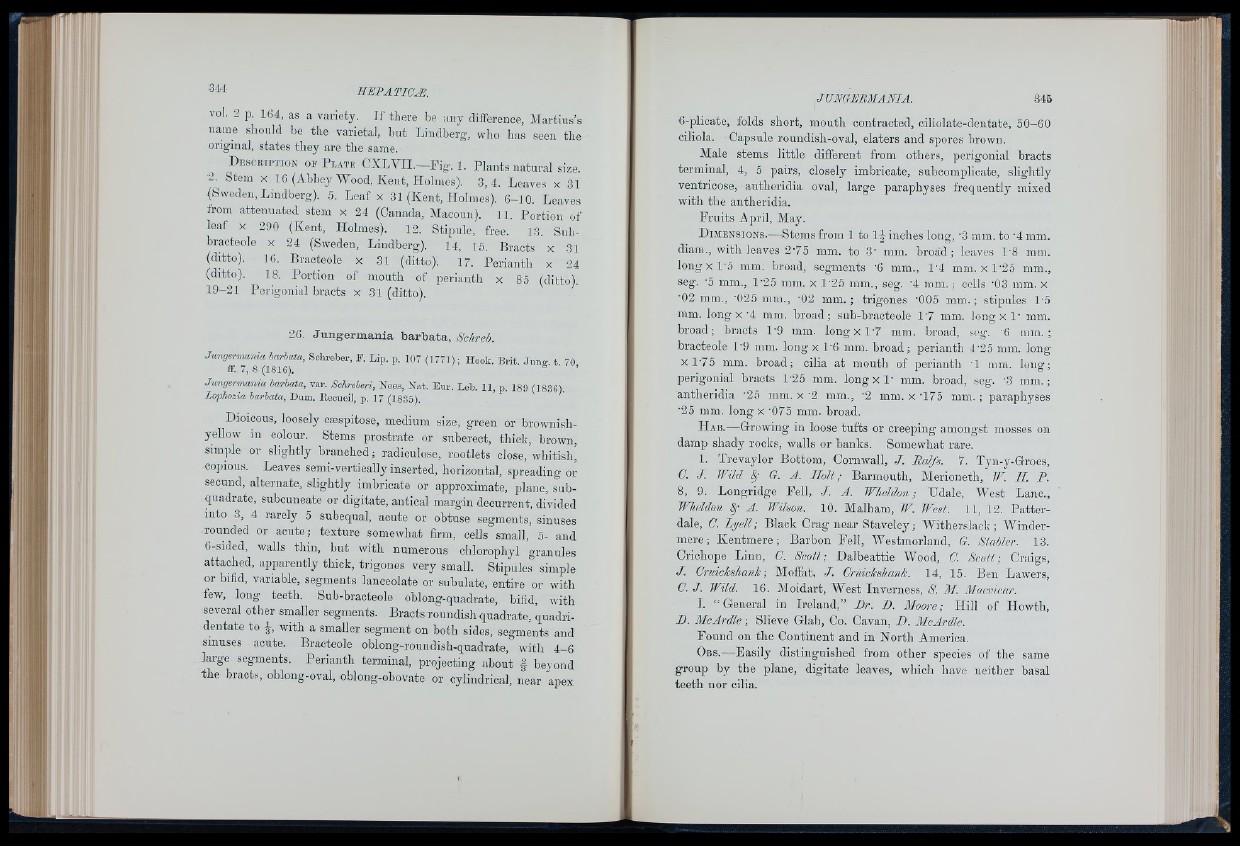
vol. 2 p. 1G4, as a variety. I f there be any difference, Martins’s
name should be the varietal, but Lindberg, who has seen tlie
original, states they are the same.
D escription oe P late CXLVIL—Fig, 1. Plants natural size.
2. Stem X lG(Abbey Wood, Kent, Holmes). 3,4. Leaves x 31
(Sweden, Lindberg). 5. Leaf x 31 (Kent, Holmes). 6-10, Leaves
from attenuated stem x 24 (Canada, Alacoun). 11. Portion of
leaf x 290 (Kent, Holmes). 12. Stipule, free. 13. Subbraoteole
x 24 (Sweden, Lindberg). 14, 15. Bracts x 31
(ditto). 16. Bracteole x 31 (ditto). 17. Perianth x 24
(ditto). 18. Portion of mouth of perianth x 85 (ditto).
19-21 Perigonial bracts x 31 (ditto).
26. Jungermania barbata, Ac/irei.
Jungermania barbata, Schreber, P. Lip. p. 107 (1771); Hook. B rit J u n v t 70
ff. 7, 8 (1816). b- • >
Jungermania barbata, var. Schreberi, Nees, Nat. Bur. Leb. 11, p. 189 (1836).
Lophozia barbata, Dum. Eecueil, p. 17 (1835).
Dioicous, loosely cæspitose, medium size, green or brownish-
yellow in colour. Stems prostrate or suberect, thick, brown,
simple or slightly branched; radiculose, rootlets close,’whitish!
copious. Leaves semi-vertically inserted, horizontal, spreading or
secund, alternate, slightly imbricate or approximate, plane, subquadrate,
subcuneate or digitate, antioal margin deourrent, divided
into 3, 4 rarely 5 subequal, acute or obtuse segments, sinuses
rounded or acute; texture somewhat firm, cells small, 5- and
G-sided, walls thin, bnt ivith numerous chlorophyl granules
attached, apparently thick, trigones very small. Stipules simple
or bifid, variable, segments lanceolate or subulate, entire or with
few, long teeth. Sub-bracteole oblong-quadrate, bifid, with
several other smaller segments. Bracts roundish quadrate, quadri-
dentate to 1, with a smaller segment on both sides, segments and
sinuses acute. Bracteole oblong-roundish-quadrate, with 4-6
large segments. Perianth terminal, projecting about f beyond
the bracts, oblong-oval, oblong-obovate or cylindrical, near apex
6-plicate, folds short, mouth contracted, ciliolate-dentate, 50-60
ciliola. Capsule roundish-oval, elaters and spores brown.
Male stems little different from others, perigonial bracts
terminal, 4, 5 pairs, closely imbrioate, subcomplioate, slightly
ventricose, antheridia oval, large paraphyses frequently mixed
with tbe antheridia.
Fruits April, May.
D imensions.—Stems from 1 to 1|-inches long, A mm. to '4 mm.
diam., with leaves 2'75 mm. to 3' mni. broad; leaves lA mm.
long X 1-5 mm. broad, segments A mm., IT mrn. x 1'25 mm.,
seg. '5 mm., 1'25 mm. x 1'25 mm., seg. T mm.; cells ’03 mm. x
'02 mm., '025 mm., '02 mm. ; trigones '005 mni. ; stipules 1'5
mm. long X T mm. broad; sub-braoteole 1'7 mm. lo n g x l ' mm.
broad; bracts 1'9 mm. lo n g x l'7 mm. broad, seg. 6 nmi. ;
bracteole 1'9 mm. long x 1'6 mm. broad; perianth 4'25 mm. long
x l'7 5 mm. broad; cilia at month of perianth '1 mm. long;
perigonial bracts 1'25 mm. lo n g x l ' mm. broad, seg. '3 mm.;
antheridia '25 mm. x '2 mm., '2 mm. x '175 mm. ; paraphyses
•25 mm. long x '075 mni. broad.
H a b .—Growing in loose tufts or creeping amongst mosses on
damp shady rooks, walls or banks. Somewhat rare.
1. Trevaylor Bottom, Cornwall, .1. Balfs. 7. Tyn-y-Groes,
C. J. Wild fl G. A. Holt; Barmouth, Merioneth, W. II. P.
8, 9. Longridge Fell, J. A. Wheldon; Udale, West Lane.,
Wheldon fl A. Wilson. 10. Malham, W. West. 11, 12. Patterdale,
C. Lyell; Black Crag near Staveley; Witherslack ; Winder-
mere; Kentmere; Barbon Fell, Westmorland, G. Stabler. 13.
Crichope Linn, C. Scott; Dalbeattie Wood, C. Scoft; Craigs,
J. Cruickshank; Moffat, J. Cruickshank. 14, 15. Ben Lawers,
C. J. Wild. 16, Aloidart, West Inverness, S. M. Macvicar.
I. “ General in Ireland,” Br. B. Moore; Hill of Howth,
B. AIcArdle; Slieve Glah, Co. Cavan, D. AIcArdle.
Found on the Continent and in North America.
O b s .—Easily distinguished from other species of the same
group by the plane, digitate leaves, which have neither basal
teeth nor cilia.
A